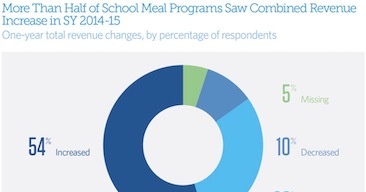
School Meal Programs Innovate to Improve Student Nutrition
December 7, 2016
Studies of schools in three states—Connecticut, Texas, and Washington—show that under the updated USDA nutrition standards, children’s eating habits are improving, which is a core goal of these strengthened policies. Students of all ages are choosing lunches higher in nutritional quality and lower in calories per gram and consuming more fruits and larger shares of their entrees and vegetables. Some studies also measured plate waste—the food taken and later discarded by kids—and found that it stayed the same or declined after the transition to healthier menus.

School Meal Programs Innovate to Improve Student Nutrition
December 7, 2016
Studies of schools in three states—Connecticut, Texas, and Washington—show that under the updated USDA nutrition standards, children’s eating habits are improving, which is a core goal of these strengthened policies. Students of all ages are choosing lunches higher in nutritional quality and lower in calories per gram and consuming more fruits and larger shares of their entrees and vegetables. Some studies also measured plate waste—the food taken and later discarded by kids—and found that it stayed the same or declined after the transition to healthier menus.
National nutrition standards influence many facets of school meal program operations, including menu planning, cooking and serving procedures, food costs, marketing strategies, and student participation rates. To investigate how updated requirements affect these areas and programs’ overall success, the Kids’ Safe and Healthful Foods Project—a joint initiative of The Pew Charitable Trusts and the Robert Wood Johnson Foundation—commissioned the School Meal Approaches, Resources, and Trends (SMART) Study.



